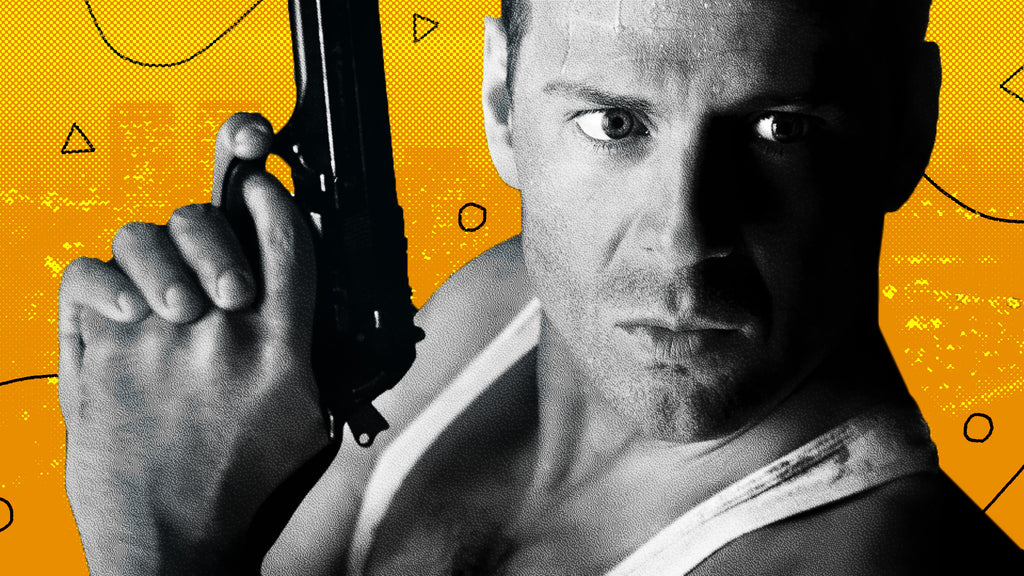Storyclock Research Log
Die Hard

This week in the Research Log, we're clocking the 1988 holiday action masterpiece DIE HARD, written by Jeb Stuart and Steven E. de Souza and directed by John McTiernan. As usual, we've watched the movie and used the Storyclock Notebook to visualize the film's structure in the form of a clock.
Let's Break It Down
- Opening Image: "Fists with your toes." John's a cop in a strange town, with a gun and a giant Christmas bear.
- Normalcy: Holly's world at Nakatomi. John and Holly are estranged, but clearly miss each other.
- Normalcy Disrupted: Hans and crew show up and take everyone hostage. John sneaks away.
- Herald: John sees Hans kill Takagi.
- Rational Approach: John pulls the fire alarm, then watches as the firetrucks turn back.
- Acceptance and Break Into Act 2: Tony shows up and tries to kill John. John kills Tony. Now I have a machine gun. Ho ho ho.
- B Story Begins: John tries to radio the police from the roof (exposing himself to Hans), and the police dispatch Al to the scene to check it out. Al will go on to be John's trusted ally.
- Trailer Moments/Promise of the Premise: Shootout on the roof, escape down the elevator shaft, "come out to the coast," "thanks for the advice," "welcome to the party, pal," etc.
- Midpoint/Arrival at Solution: The LAPD show up. But turns out they just make everything worse.
- Things Get Worse: The cops try to come in and it blows up in their faces. Ellis takes matters into his own hands, gives Hans John's name, dies.
- Hero's Last Resort: Hans basically brings himself to John. John tricks him into revealing who he is. "Oops. No bullets."
- Worst Fears Realized: Karl and other dude show up and John loses the upper hand. Hans and Karl exploit John's biggest weakness and shoot the glass. Now Hans has the detonators. John has glass in his feet. The FBI shut off the power, consequently opening the last door of the vault for the terrorists.
- Game Over: John pulls glass out of his feet while Al reveals why he works at a desk now: he had an incident where he accidentally shot a minor. So he's too afraid to ever fire a weapon again. John asks Al to tell Holly he's sorry for not supporting her and being the husband she deserved.
- Breakthrough and Rebirth/Break Into Act 3: Al tells John, "tell her yourself. Watch your ass and you'll make it out of there." John replies, "I guess that's up to the man upstairs." The word "upstairs" makes something in John's head click. "What the f--- were you doing upstairs, Hans?" He goes upstairs and realizes Hans's plan to blow up the roof.
- Hero Gains Upper Hand:John fights Karl and appears to kill him. He gets the hostages off the roof, saving them. He Die Hards off the building as it explodes, carving iconic imagery into film history immediately.
- Shadow's Final Push: Hans discovers Holly's connection to John. Takes her hostage.
- Ultimate Breakthrough: John finds Holly and Hans, duct tapes a gun to his back with only two bullets left and goes in like a cowboy, killing the Huey Lewis clone and knocking Hans out the window. Nice touch that it's the watch Ellis gave Holly that cuts Hans loose.
- New Normalcy: John and Holly are reunited. And Al saves everyone by shooting zombie Karl, overcoming his personal demons.
- Final Image: John and Holly get in limo and ride off to Christmas music.
Stuff That Stood Out To Me
- John's objective evolves through several clear and defined stages, from "alert the authorities," to "stall the terrorists while we wait on the authorities," to "turns out the authorities are useless, I better stop them from making things worse," to the 'all is lost' moment of "what even is my objective anymore I have glass in my feet," to the big ultimate external third act objective of "save the hostages," to finally the big ultimate internal whole movie objective of "save my wife/marriage." When you remember the movie, you remember it as a "John fighting the badguys and saving the hostages" movie, but it takes the whole movie to get John to commit to that.
- "Fists with your toes" gets his shoes off. Without it, we really don't have any justification to get his shoes off. Why get his shoes off? Because it makes him more vulnerable, but more importantly, because it's an interesting and weird and specific choice that twists your expectations.
- After John turns a nice moment into an argument, Holly is summoned by a coworker and has to leave the room. Then we get this nice moment where John bangs his head on the doorframe, immediately regretting the way he handled the situation. This is a great way to keep us liking him, because we all do this. It's such a human thing. Imagine if she had left the room and he just stayed mad at her -- he'd be an asshole. Instead he's a human.
- William Atherton's douchey reporter character (I call him Walter Peck in the clock, because that's how I'll always know him) shows up around the time Al does, and then we keep checking in with him because... why? That's what I wondered for years. To me, he always seemed like this cynical 80's sterotype: a resident asshole. BUT he actually serves a crazy important purpose -- he finds his way to Holly's house and interviews the kids, which Hans sees at the just the right/wrong moment to realize that Holly is not just Miss Gennaro, she's also Mrs. McLane.
- Speaking of that moment -- Hans is basically home-free at that point. He probably would've gotten away had he not acted on that revelation. Holly would have gone to the roof with the other hostages, where John would have found her and led everyone back downstairs. The roof would've exploded but John would've let Hans escape, because he would've been reunited with his wife then. But that's not what happens. Instead, Hans lets his pride and anger get the best of him. Thankfully, for us.
- Also speaking of Miss Gennaro -- how brilliant of a device is Holly's last name? Not only only does it deliver us a world of exposition and context in a single quiet moment in the first act, and not only does it communicate the journey of the two lead characters and their relationship, but it also gives Hans the final piece of the puzzle to raise our stakes to their maximum level in the third act.
- There's some masterful scene construction in this movie. Every scene has its own narrative job to do, and its own unique way of doing it. A good example is this moment when Hans is looking for Takagi:
I am obessed with the way this moment plays out -- how Hans saves the most personal and vulnerable bullet point (he's a father of four) for the moment he's looking him in the eye. How it establishes Holly as a smart and savvy leader in high-stakes situations. How it establishes Takagi as a good man protective of his employees.
DIE HARD isn't just an action movie set at Christmas. It's an action movie about Christmas. It's about an estranged couple trying to reunite at Christmas (family and humanity trying to happen and be a thing), and a bunch of glorified bank robbers (greed and materialism) interfering and jeopardizing the family and the love. See what I did there?
But seriously, DIE HARD's story doesn't just feature Christmas, it relies on it. Just like it relies on pretty much every other thing that's in it. DIE HARD is an efficient and cohesive story machine, with a badass but vulnerable hero, a brilliant but flawed villain, and a badass self-sufficient female character. And a partridge in a pear tree.
Merry Christmas, everyone!




